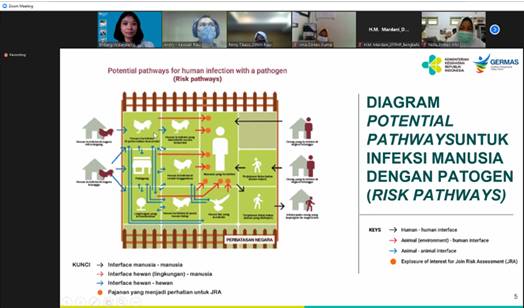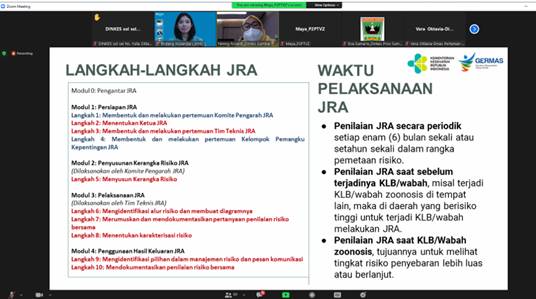Zoonosis, a disease or infection that is naturally transmissible from vertebrate animals to humans, remains a public health problem. Globally, 70% of emerging infectious diseases (EIDs) originate from zoonotic pathogens. About one billion cases of illness and millions of deaths caused by zoonoses occur every year.
In Indonesia, zoonoses remain a challenge. Therefore, participants in the One Health Zoonosis Diseases Prioritization (OHZDP) workshop from 8-11 November 2021 agreed on six zoonotic priority diseases in Indonesia: zoonotic influenza (avian and swine influenza), zoonotic coronavirus (COVID-19, MERS-CoV), rabies, anthrax, tuberculosis zoonosis and leptospirosis.
Multidisciplinary and multisectoral collaboration in One Health approach are needed to tackle zoonotic diseases and reduce their impact. Thus, it is crucial to streamline and standardize guidelines and modules to improve capacity and collaboration for zoonosis prevention and control among human, animal, wildlife and environmental sectors. Furthermore, joint risk assessment (JRA) for zoonoses is important, gathering national information and expertise from all the relevant sectors to assess health risks from zoonotic diseases to fully understand and manage shared risks deriving from human-animal-environment contacts.
WHO, FAO, and OIE developed a tripartite guide to address zoonotic diseases in countries, taking a multisectoral One Health approach. WHO and FAO supported MoH collaboration with MoA and MoEF in adopting the tripartite zoonosis guide. The collaboration supported the development of curricula and training modules for One Health zoonosis control. The development of curricula and training modules was also supported by the Australian Government (DFAT).
The One Health zoonosis training module covers an overview of the One Health approach; policy on zoonosis control in human, animal and wildlife; epidemiology of zoonoses; zoonosis surveillance; joint field investigation for zoonosis outbreaks; overview of the JRA tool; risk communication for zoonosis control; and development planning for the zoonosis control programme. While the JRA training module focuses on steps to conduct JRA; preparation for JRA; development risk framing; risk pathway; risk questions; and characterization of risk; followed by the development of recommendations and risk communication for zoonosis prevention and control.

Fig. 1. The facilitator presented diagram risk pathway as one of JRA steps during JRA orientation in Riau province. Credit: Endang Widuri Wulandari/ WHO.
On September 2021, following the development of the JRA module, WHO and FAO supported MoH, MoA and MoEF to conduct an orientation of JRA in ten provinces (Riau, West and North Sumatera, South and Central Kalimantan, DI Yogyakarta, Central Java, South and North Sulawesi, and Bali). A total of 531 participants and 62 provincial-level facilitators actively engaged during the discussions and group exercises. Besides improving technical capacity, the JRA orientation also served as forum to enhance cross-sectoral coordination among human, animal and wildlife sectors.

Fig. 2. MoH presented Joint Risk Assessment (JRA) steps, West Sumatera, 7 September 2021. Credit: Endang Wulandari/WHO.
The One Health training module for zoonosis prevention and control will be used as a standard systematic module for One Health zoonosis training. The module will be used to improve and build the capacity for zoonosis prevention and control in One Health approach for human, animal, and wildlife sectors.
***
